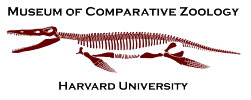Aves - Palaeognathae - Struthioniformes - Dinornithidae - Euryapteryx - †Euryapteryx gravis
Left Tarsometatarsus (Left Fused Element Consisting of Ankle and Middle Foot Bones) of a †Euryapteryx gravis (†Stout-legged Moa)
Rotate: left click on mouse
Zoom: right click on mouse (PC) or command and click (Mac)
Move: left and right click simultaneously (PC) or shift and click (Mac)
| Species Description |
|---|
|
One of the largest birds to have ever lived, some species stood almost 12 feet tall and could weigh up to 500 pounds. Moas exhibited significant reverse sexual dimorphism, with females being up to 150% taller and 280% heavier than males. These size variations within species made it difficult for researchers to determine if remains belonged to the same or different species, and complicated the number of suspected species. Given current knowledge, there are ten accepted species of moa, representing six genera. The Stout-Legged Moa lived primarily in shrublands and subalpine forests; larger species were usually restricted to more open grasslands. Their diets consisted mostly of fibrous plant material, and they swallowed small stones (gastroliths) to aid with digestion. Some moas, including those of the genus Euryapteryx, exhibited tracheal elongation; the tracheas of these birds could be up to three feet long, and they formed a large loop within the body. Moas are the only known ratites to have this feature, though it is common in several other bird groups (such as swans, cranes, and cracids). Elongated tracheas are commonly associated with deep, resonant vocalization, which suggests that moas could have called over long distances. Given their large size, the moa’s only natural predator for most of its existence was Haarsts eagle, commonly thought to be the largest eagle to have ever lived (Haarsts eagles had 8-10 foot wingspans and could weigh up to 33 pounds). However, after the arrival of the Maori around 1300 AD, overhunting and (to a lesser extent) forest clearance drove the moa (along with the Haarsts eagles) to extinction; modern population models suggest that this process took less than 100 years. References Holdaway, RN and Jacomb, C. Rapid Extinction of the Moas (Aves: Dinorinthiformes): Model, Test and Implications. Science 287:2250-2254 (2000). Huynen L, Millar CD, Scofield RP, Lambert DM. Nuclear DNA sequences detect species limits in ancient Moa. Nature 425:175-178 (2003). Wood JR, Rawlence NJ, Rogers GM, Austin JJ, Worthy TH, Cooper A. Coprolite deposits reveal the diet and ecology of the extinct New Zealand megaherbivore moa (Aves: Dinorinthiformes). Quaternary Science Reviews 27:2573-2662 (2008). Worthy TH and Holdaway RN. The lost world of the moa: Prehistoric life in New Zealand. Indiana University Press (2002). |
| Skeletal Elements Available |
|
Sternum (Breast Bone) |
Left Tarsometatarsus (Left Fused Element Consisting of Ankle and Middle Foot Bones) |
Rib (Rib) |
| External Links |
|---|




